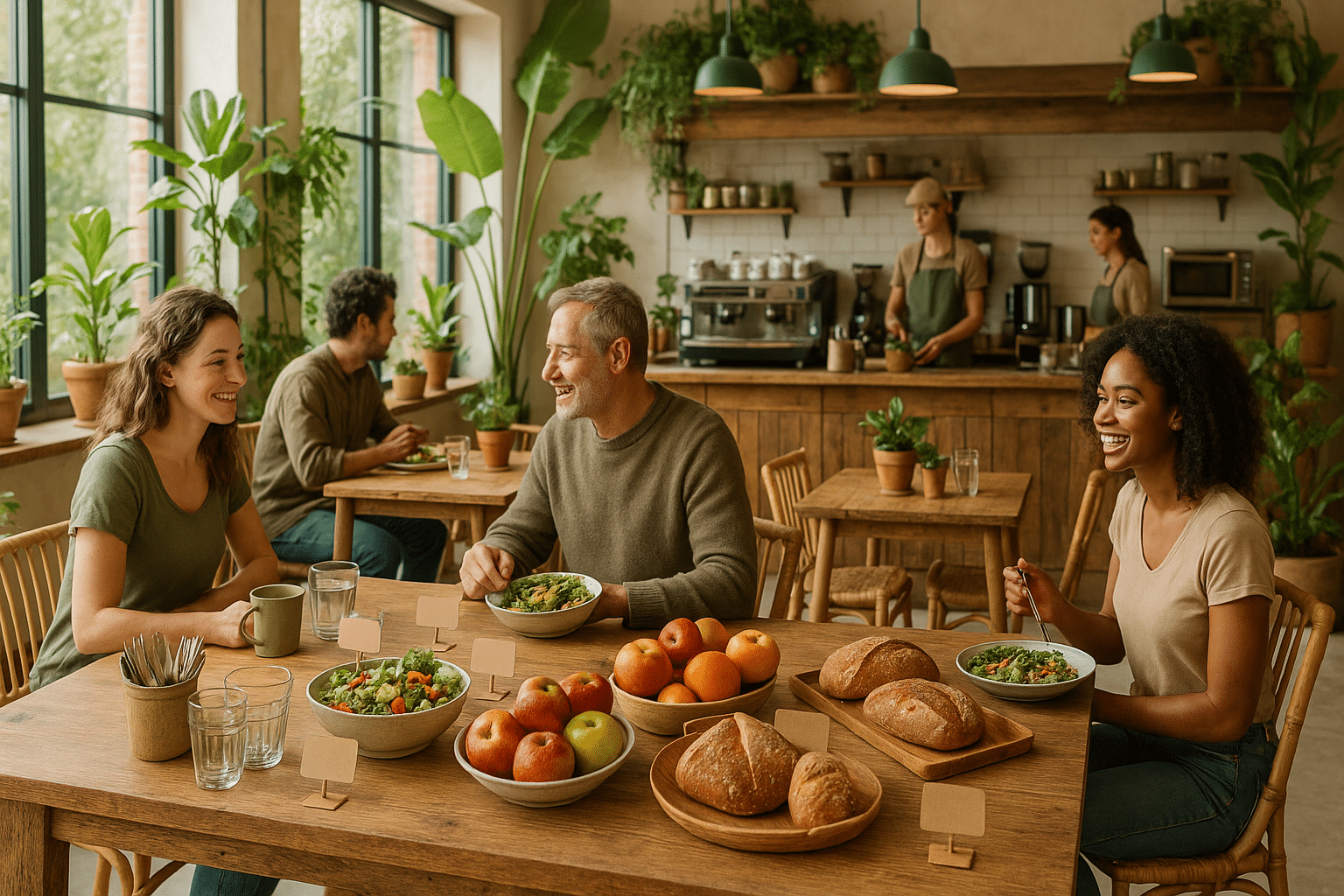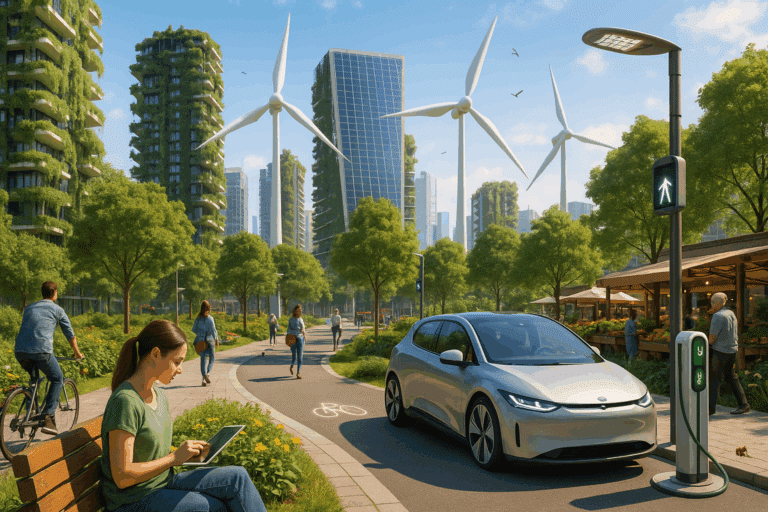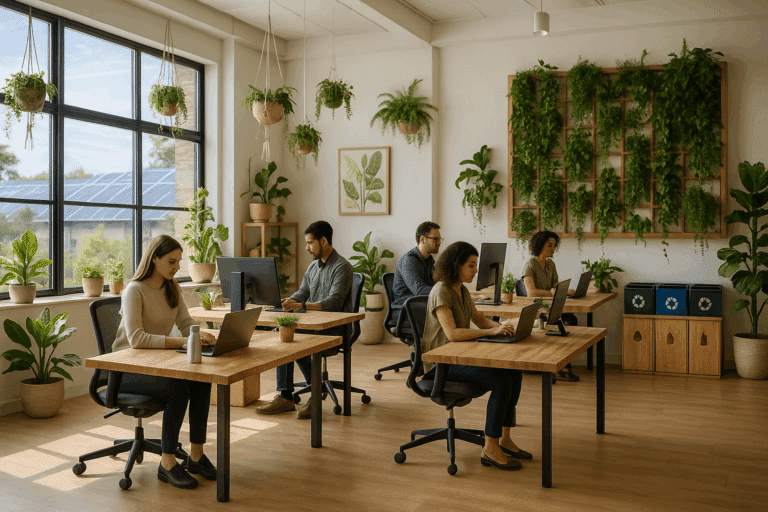🌱 Yes, you read it right! It’s all about ‘Eco-Friendly Eats: Building a Greener Future with Sustainable Cafeterias and Dining Practices’. This article delves into this remarkable intersection of food, culture, and the environment, exploring how our dietary choices and dining practices can contribute to a sustainable future.
Modern society is increasingly recognizing the need to adopt sustainable living, driven by an understanding of our shared responsibility to protect our environment. But have we ever considered the environmental impact of the very meals we eat every day? The answer may be a surprising revelation for many.
Our global food system is responsible for approximately one-quarter of the world’s greenhouse gas emissions, making it a significant contributor to climate change. What we choose to eat, how it is produced, and where we consume it – in the comfort of our homes, at bustling restaurants, or within the walls of our favorite cafeteria – all these factors play a pivotal role in determining our carbon footprint.👣
But there’s a silver lining here. Because our food choices have such a significant environmental impact, they also hold the potential for enormous positive change. And this is precisely the exciting journey we will embark on in this article, exploring how sustainable cafeterias and dining practices can help us build a greener future. 🌍
Unwrapping the Meal: Understanding the Environmental Impact
The first part of our article will provide a comprehensive understanding of the environmental impact of our food system. We’ll analyze the entire life cycle of a meal – from farm to fork, highlighting the carbon footprint of different food items and how various stages of production, transportation, and consumption contribute to greenhouse gas emissions. Expect some eye-opening revelations as we uncover the hidden environmental cost of our favorite meals. 🍽️
Serving Sustainability: The Role of Cafeterias and Dining Practices
Next, we will take a closer look at cafeterias and dining practices, exploring how these places can serve as effective platforms for promoting sustainable eating. We will share examples of innovative practices and strategies implemented by cafeterias around the world, from sourcing local and organic food to reducing food waste. 🥗
Building a Greener Future: Opportunities and Challenges
In the final section of our article, we will discuss the opportunities and challenges in transitioning towards sustainable cafeterias and dining practices. We will examine the role of technology, policy, and consumer behavior in driving this change, and how they can overcome existing barriers. 🚀
Whether you’re a foodie, environmental enthusiast, or simply curious about how your eating habits can contribute to a sustainable future, this article promises to offer valuable insights. So grab a cup of your favorite eco-friendly coffee ☕, sit back, and let’s embark on this journey towards building a greener future, one bite at a time! 🌱
The Growing Green Movement: An Introduction to Sustainable Cafeterias and Dining Practices
In recent years, the world has witnessed a growing awareness of the impact of human activities on the environment. This has sparked a new wave of innovation in various sectors, including the food service industry. One significant development is the advent of eco-friendly dining practices, epitomized by the rise of sustainable cafeterias. In this article, we will dive into the world of sustainable cafeterias and dining practices, investigating how they contribute to a greener future and the specific strategies employed. We will also explore the benefits and challenges of this approach, providing a comprehensive overview of this burgeoning field.
Before we proceed, if you’re more of a visual learner, I highly recommend this YouTube video titled “Sustainable Food: The New Farm-to-Table Trend” by the World Economic Forum. It provides an excellent overview of the sustainable dining movement, giving real-world examples and insights.
Understanding the Concept of Sustainable Cafeterias and Dining Practices
The fundamental idea behind sustainable cafeterias is the use of practices and technologies that minimize environmental impact and promote social responsibility. It encompasses everything from the sourcing of food, the energy used in preparation, the disposal of waste, and even the design of the dining area. The ultimate goal is to create a food service system that is not only efficient and profitable, but also environmentally friendly and socially equitable.
However, sustainability is not a one-size-fits-all solution. What works in one setting may not work in another. Therefore, it’s essential to understand the specific needs and constraints of each situation and to customize solutions accordingly. This often involves a careful analysis of the entire food service process, from farm to plate, and the identification of areas where improvements can be made.
Let’s examine a typical sustainable cafeteria’s operations in the table below to get a better understanding of this concept.
| Process | Sustainable Practice |
|---|---|
| Food Sourcing | Local and organic produce, sustainable seafood, fair-trade products |
| Food Preparation | Energy-efficient appliances, waste reduction measures, environmentally friendly cleaning products |
| Waste Management | Composting, recycling, use of biodegradable packaging |
| Dining Area Design | Use of natural lighting, energy-efficient lighting and heating, recycled and sustainable materials |
For an in-depth exploration of these practices, please watch the following YouTube video: “Sustainable Restaurant Practices: Farm to Fork” by Eco Eye. The video provides a detailed walkthrough of a sustainable food service operation, highlighting the key strategies employed and their benefits.
The Benefits of Sustainable Cafeterias and Dining Practices
Sustainable cafeterias offer a myriad of benefits, not just for the environment but also for the businesses that adopt these practices and their customers. Some of these benefits include:
- Environmental Conservation: By reducing waste and energy use, sustainable cafeterias help to conserve natural resources and mitigate climate change.
- Health and Wellness: Sustainable food sourcing often results in healthier and fresher meals, contributing to the overall well-being of the customers.
- Cost Savings: Many sustainable practices, such as energy efficiency and waste reduction, can also lead to significant cost savings in the long run.
- Reputation and Branding: Businesses that adopt sustainable practices are often viewed more favorably by customers, which can enhance their reputation and branding.
Challenges and Solutions in Implementing Sustainable Cafeteria Practices
Despite the numerous benefits, implementing sustainable cafeteria practices is not without its challenges. Some of these include the higher initial cost, difficulty in sourcing sustainable food products, and resistance from staff or customers. However, many of these challenges can be overcome with the right strategies and approaches.
For instance, while the initial cost of implementing sustainable practices can be high, the long-term savings often outweigh these costs. Additionally, businesses can take advantage of various incentives and grants available for green initiatives to offset these costs. Regarding sourcing, businesses can form partnerships with local farmers and food cooperatives to ensure a steady supply of sustainable products. As for resistance, education and training can play a significant role in changing attitudes and behaviors.
If you’re interested in learning more about how to overcome these challenges, I recommend watching the YouTube video “Sustainable Food: Overcoming Barriers” by the World Economic Forum. It offers valuable insights and practical advice from industry experts on this topic.
Case Study: Successful Implementation of Sustainable Cafeteria Practices
Now that we’ve discussed the concept, benefits, and challenges of sustainable cafeterias, let’s take a look at a real-world example of a successful implementation. The University of California, Berkeley, has made sustainability a priority in its dining services. Their efforts have earned them recognition as one of the most sustainable campuses in the U.S. To get a glimpse of their journey towards sustainability, watch the YouTube video “UC Berkeley: A Leader in Sustainable Dining” by Cal Dining. Their story can serve as an inspiration and a practical guide for others looking to embark on this journey.
In conclusion, sustainable cafeterias represent a significant step forward in our efforts to build a greener future. They embody the principles of environmental conservation, social responsibility, and economic viability, showing that it’s possible to have a food service system that’s not only profitable but also beneficial for the planet and its inhabitants. As we continue to innovate and refine our practices, the dream of a sustainable food service industry may soon become a reality.

Conclusion
In conclusion, the past sections have painted an intricate picture of the landscape of software engineering, particularly in the realm of Information Technology. We began with an in-depth exploration of the core principles that underpin the field, delving into the methodologies and strategies that developers employ to construct, maintain and evolve software systems. We discovered that software engineering is far more than mere coding; it’s an intricate process involving planning, system design, coding, testing, and maintenance, all guided by a set of well-defined principles.👨💻
We then shifted our focus to the critical role of Agile methodologies in modern software engineering. Agile methodologies, we learned, are not just tools for project management, but a holistic approach to software development that prizes flexibility, collaboration, and customer satisfaction. Our exploration of Agile methodologies, from Scrum to Extreme Programming, revealed how these frameworks could streamline the software development process and foster a more productive and efficient work environment. 🚀
Our discussion of Software Architecture Patterns shed light on the importance of structural design in software engineering. We understood that these patterns serve as templates or blueprints, guiding developers in organizing complex systems into manageable, modular components. We discussed several popular architecture patterns, such as the Microservices and MVC, highlighting their benefits and trade-offs. 🏗️
On the topic of Artificial Intelligence and Machine Learning, we considered their transformative impact on the software engineering field. We looked at how AI and ML are revolutionizing aspects of the development process, from automated testing to predictive programming, and pondered their potential future impact. 🤖
The importance of cybersecurity in software engineering was another critical topic. In our increasingly digital world, the security of software systems is paramount. We discussed the inherent risks and vulnerabilities in software development and examined the strategies and best practices for creating secure, robust software systems. 🔒
As we wrap up this comprehensive guide, it’s crucial to remember that while the landscape of software engineering is vast and ever-evolving, the foundational principles remain steadfast. Understanding and adhering to these principles, coupled with continuous learning and adaptation, is the key to success in this dynamic field.
I hope this exploration has provided you with a deeper understanding and a broader perspective of the complexities and nuances of software engineering. Whether you’re an experienced developer looking to refine your skills or a budding enthusiast just beginning your journey, there’s always something new to learn and explore in this vibrant field. 🎯
Feel free to drop your thoughts or questions in the comment section below or share this article with others who might find it useful. For further reading, I highly recommend the IEEE Computer Society’s Technical Committee on Software Engineering and the ACM Special Interest Group on Software Engineering (SIGSOFT).
Remember, the journey of a thousand miles begins with a single step. So, start small, keep learning, and before you know it, you’ll be making significant strides in the world of software engineering. Let’s continue the exploration together! 💡🌐



